Remembering Jere Osgood (1936 – 2023)
“The lines and shaping of the parts were very specific but how we got there was not.”

Recollections by Ted Blachly
Warner NH 2023
I first met Jere in 1990 at a meeting for the Guild of NH Woodworkers. He seemed like a quiet workman and at the time I had no knowledge of who he was or his place in the studio furniture field. That changed three months later when I saw his Ebony Desk (1989) with its fluted upper section and curving ash legs on a postcard announcement from Pritam & Eames….He made THAT!!…I was absolutely stunned. It was and still is one of the most amazing pieces of furniture I have ever seen.

The Guild formed and we started having monthly meetings at different people’s shops. These usually included a demo and talk by the host. The first one at Jere’s was packed and his presentation was so thoroughly put together. It was something I would continue to appreciate as I got to know him — his thoroughness.
Fast forward to Jan 1993. Jere called to see if I wanted to help him part time in the shop. I eagerly accepted. The history of our friendship and my assisting him with his work now spans over thirty years. It was easy and an honor to devote myself to helping him move his work along. I lovingly say I was like a tool he hung on the wall in his shop to use as needed. It was so much more though and I learned a lot.
Nicola Taylor was his other assistant and she did primarily shaping and sanding of the parts plus some veneer fitting. In the beginning I believe I was brought in to help with the joinery fitting as well as learn the hand shaping and sanding. Chairs were underway so that’s where he started me. And so it went. I would continue work as needed for a few days here and there. As my sensitivity and craftsmanship developed, the things I did in the shop also expanded.
His wealth of knowledge and the details of what he did were vast. He didn’t offer much step by step direction. There is too much to know and I think he knew how to best cultivate a sensitivity in approach. The lines and shaping of the parts, for example, were very specific but how we got there was not. It didn’t matter if you were using a spokeshave or rasp as long as the end result was where he wanted it to be.
The tone in the shop was relaxed, warm and well lit — naturally and with incandescent lighting. His humor, good nature and focus helped ease me into being around such greatness. I think looking back there was tolerance too — his knowing that working at this level was not instantaneous. His drawing table was a place where I could really feel his focus. It was brightly lit and the classical music station or maybe a Keith Jarrett CD would be playing at a healthy volume. Approaching him with a question was something I felt I had to do carefully, not wanting to interrupt.
One of his favorite pieces is the Layton Table. I got to watch that unfold as he was designing it. I would be working at my bench and this little mockup, made from pine with a cardboard top, was taking form on his side of the shop. He and Nikki would be looking at and talking about it but my place was paying attention to my chair part work. I felt myself wanting to steal glances, drawn like a moth to a flame. He would set it up on his drawing board and I would peer around the corner for a peek. When he would go into the house for lunch then I could have a good look. The asymmetry of it I believe was something new. When explaining it to me he said “When you make a table you have a top, then for the legs, you imagine four points at the corners going down to the floor to support it.…but how they get there doesn’t matter”. Interesting concept in the case of the Layton Table, he just pushed the pedestal off to the side. The table was well balanced and the base would just fall over if the top wasn’t on. So he would hang a crescent wrench by a wire off one of the arms to keep the base standing while one was in process.
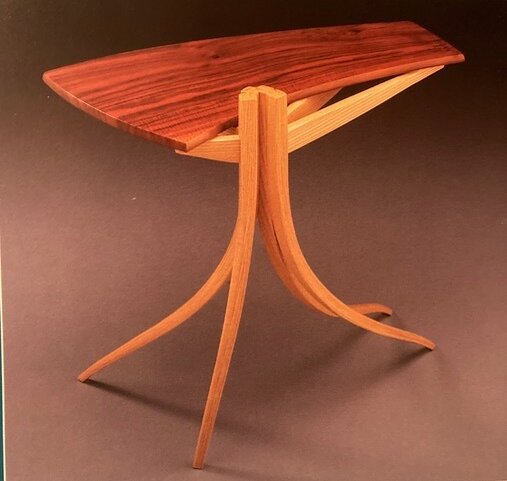
There were a few different designs and runs of chairs made over my years there. One was a set of three — two in hornbeam and one in curly cherry — with red leather upholstered seats. There is a quiet elegance to these but they were extremely complex to make. He was a master of articulating his designs with sketches, full scale drawings and mock ups. Then came the making of jigs and patterns to produce the parts. Then there was the fitting and subtle, but detailed shaping and sanding to blend the parts together. The crest rails were very important to him and on this set there was a shaped cut out in the center that flowed into the two back supports. All these pieces had to fit in a number of places. He called this stage, with his inimitable humor, “A detail that would make you want to leave the field.”

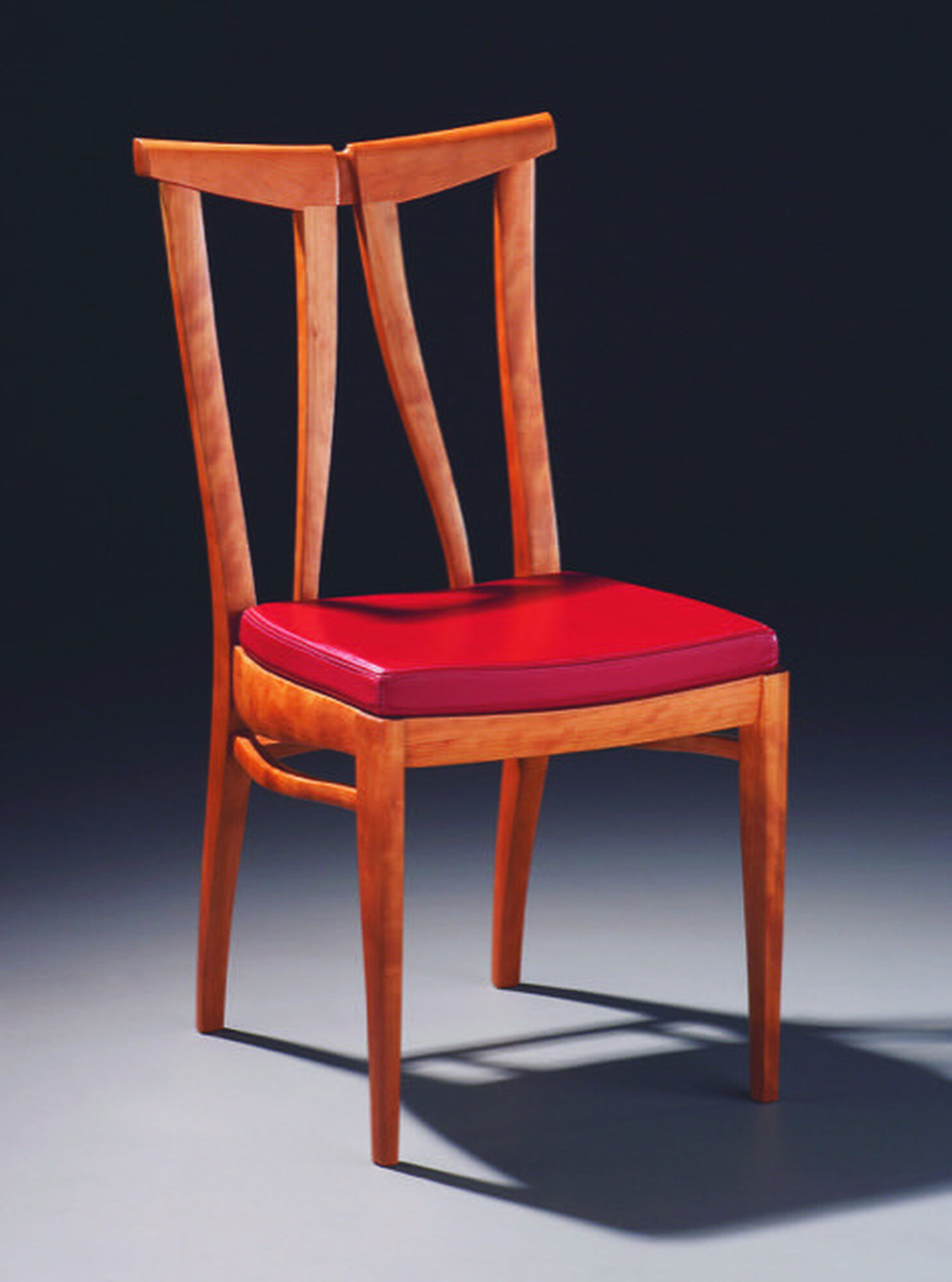
Jere Osgood Curly Cherry Chair


Jere Osgood Curly Cherry Chair - Detail of Crest Rail

One of his words was “unflat”, which referred to the shaping or doming of surfaces. It made the furniture reflect light differently than flat surfaces and was also friendlier to the touch.
His furniture, technical innovations, artistic vision and impact as a teacher is well documented and worthy of study. He left us with so much from a long life and career.
There is a gem in his 2001 Oral history interview done by The Smithsonian Archives of American Art where at age 14, he recalls delivering a bookcase in the winter lashed to his sled — in Staten Island NY, where he grew up — that he had made or remade(?). Anyone I’ve ever met who finds their life’s passion that early surely has a jump on things…..long live Jere Osgood!

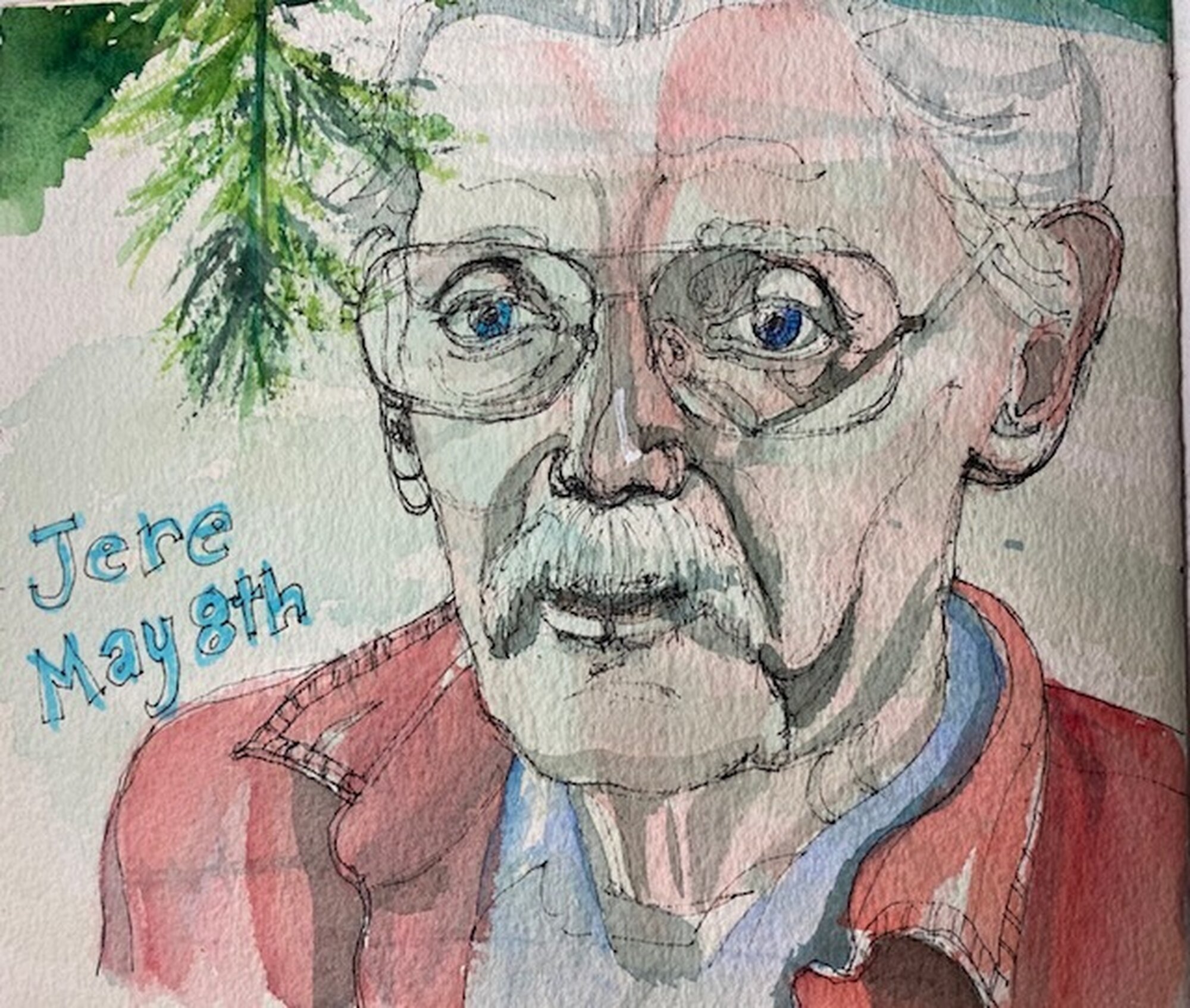
Sketch of Jere by Amy Forsyth


Sketch of Jere's House by Amy Forsyth
Recollections by Amy Forsyth
Here is a sketch I did of Jere, in 2013, at his house (also included). As I recall, I did this in person, in his sunny dining room, in the Spring, as he spoke to me of many lovely things. In addition to being grounded in the physical realm of weight and gravity and the demands of material, he was also a bit of a mystic. He spoke of out of body experiences, and perceiving objects, such as furniture, while in motion, and how those imagined flights impacted his design process. His love of nature, of the textures of leaves and bark and the shape of the human form can all be perceived in his brilliant work. He loved music, and I did my best to play the prettiest fiddle tunes I could find for him. He loved a nice scotch, especially when he wasn’t supposed to drink it anymore. His humor, delivered in quiet deadpan, was unexpectedly delightful. He was one of the guideposts of my creative life, beginning with workshops and interviews for articles and growing into a deep friendship and a sense of being kindred spirits. How fortunate we all have been to have known him.

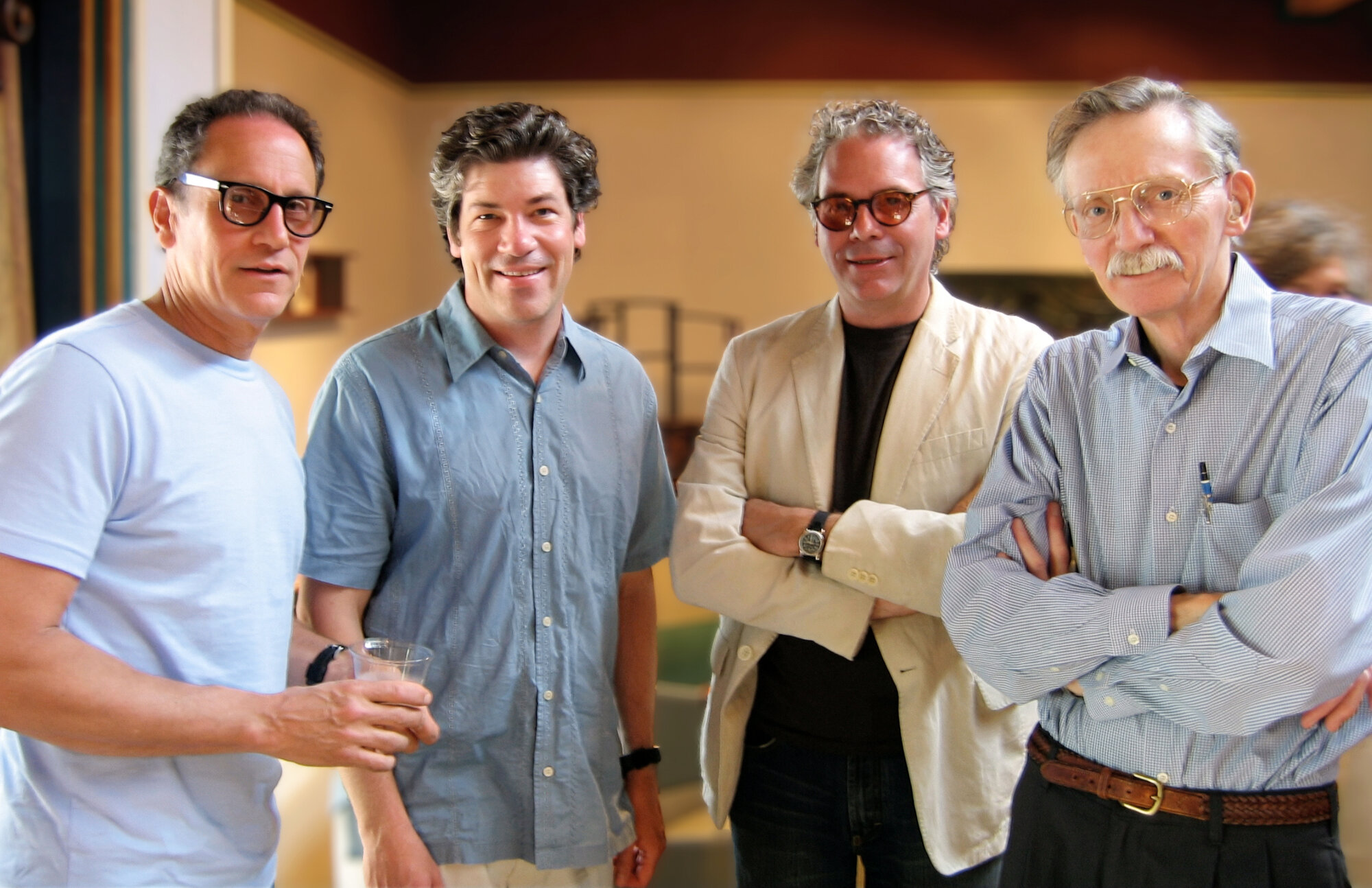
James, Andy, Tim, and Jere at Pritam & Eames Opening

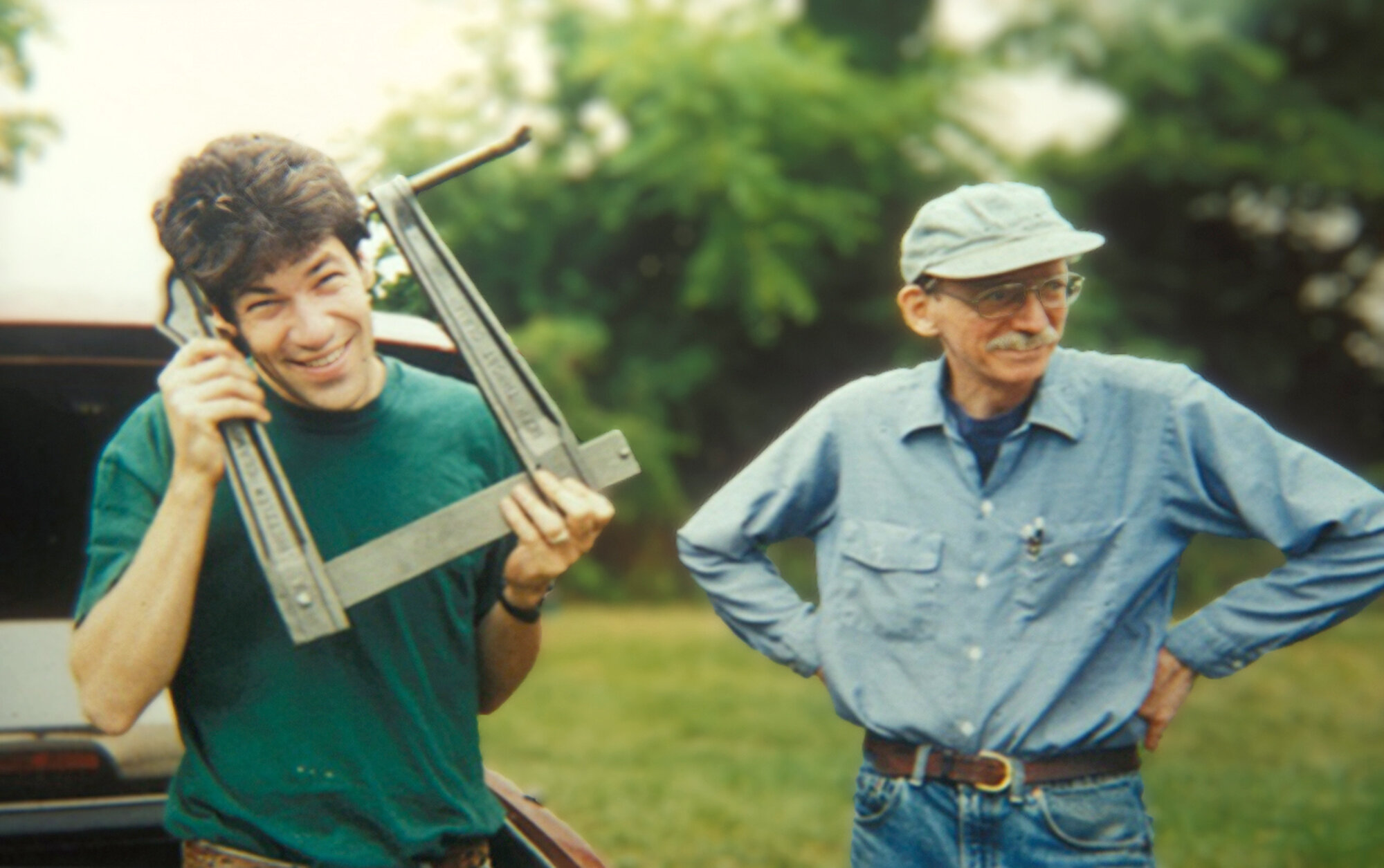
Jere and Andy at Peters Valley 1995

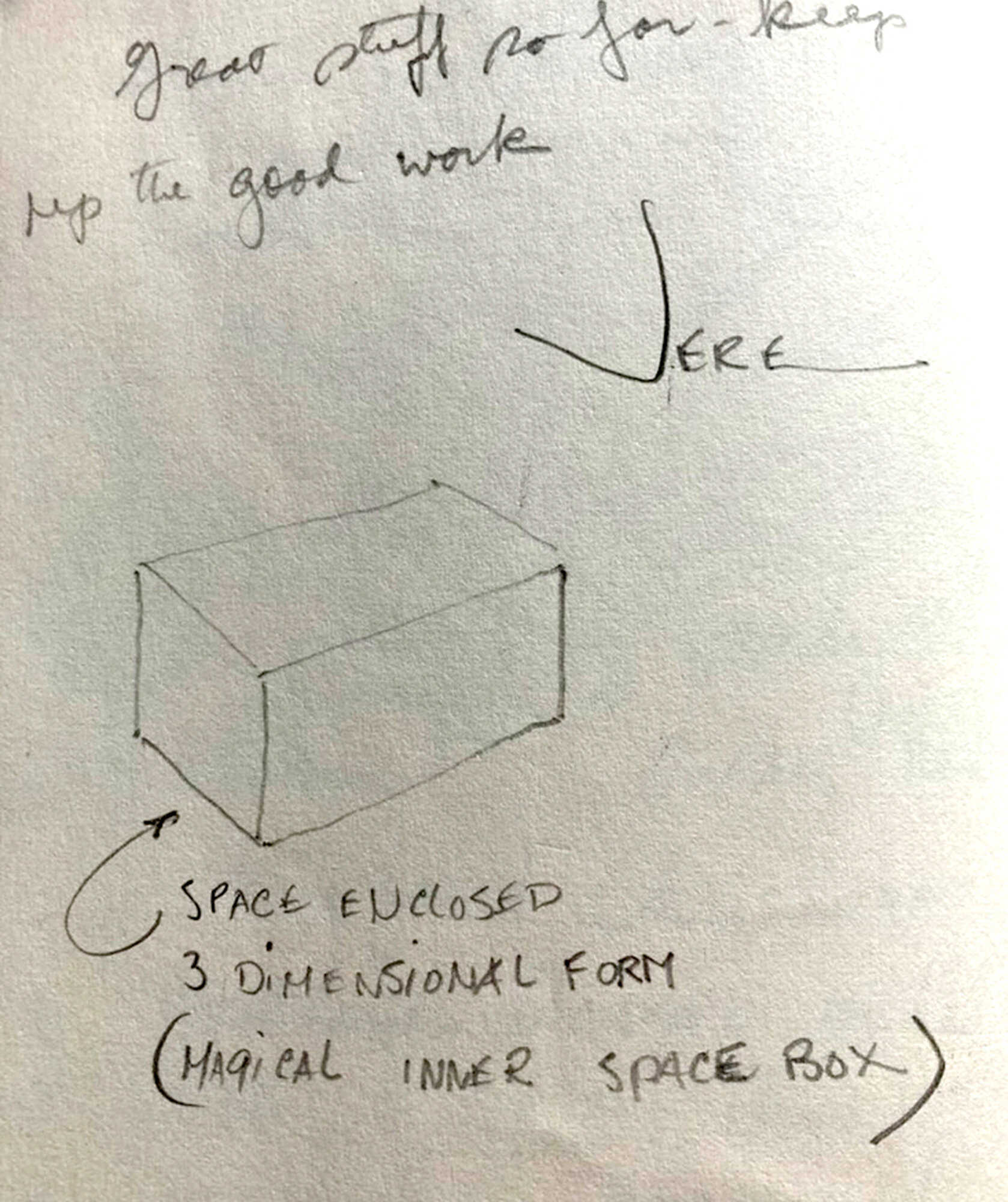
Note from Jere
Recollections by Andy Buck
I first became aware of Jere Osgood’s work early in my college years, seeing his furniture published in magazines and books, at gallery exhibitions, and in slide presentations. I marveled over his use of gentle swelling wooden forms, beautiful reverse curves, and the subtle flow and integration of elements in his work. These were a consistent part of Jere’s design vocabulary. Any experienced woodworker could comprehend the complexity these curves brought to the making of an object, but he made everything look so seamless. Jere’s innovative woodworking techniques were legendary, such as tapered lamination, complex coopering, cutting dovetails on a radiused edge, making his own hardware. Then there were nuanced things like making his own varn-oil finish, and oddball things like covering bent laminations with an electric blanket to induce the cure of plastic resin glue. I loved all this. Clearly, Jere Osgood was as much an innovator and inventor as he was one of our country’s greatest furniture makers. Later, I learned so many things from Jere directly. Concepts that have stuck with me over the years, both as a maker and as a teacher. He stressed the importance of creating hierarchy — but also harmony — between structure and design, and using construction methods that enhance the flow and form of a piece. Jere conceived of furniture in architectural terms, often talking about “using inside and outside space” and “thinking about open and closed forms.” He taught me to look beyond the conceived archetype of any given piece of furniture when trying to discover new ideas, and also, that it is ok for good craftsmanship to be invisible.
I first met Jere Osgood in 1995 when he came to teach at Peters Valley Crafts Center. As the studio coordinator, I had the opportunity to assist his workshop, and in the process witnessed his wonderful demeanor as a teacher. He was a technical master, but did not wear it on his sleeve. And, Jere was not the type of teacher who would tell you what to do. He was not loquacious. Instead, he asked questions to learn about each student’s goals. I can recall one time asking advice about a sketch:
Me: “Maybe I should make this bigger.”
Jere: “That might be good.”
Me: “But then again, maybe smaller could be more intimate”
Jere: “True, that’s a good point. I can’t wait to see what you do!”
I think when it came to design, Jere really believed that his students could figure out their own answers, and it was important that they develop their own methods for creative problem-solving.
Over the years, I loved to check in and see what Jere was working on, and I don’t think he minded my frequent phone calls to his home and studio too much. He would share technical details about a piece, maybe the process of making a shell desk, then humbly shift our conversation to talking about his cat. Often I would seek his advice about my own work, or talk through challenges I faced as a new professor at RIT, where Jere attended and also taught before leading the legendary furniture design program at Boston University. Although an icon in our field, Jere was incredibly kind and generous. When I had my first solo exhibition, Jere drove all the way from New Hampshire to Clark Gallery to attend the opening. What a boost this was when I was just starting out! Almost thirty years later, this still blows me away. For every letter of recommendation, teaching promotion, etc., Jere gave me support. When our son was born, Jere sent Sandy and I a beautiful curly maple baby rattle as a gift. His note said, “Here is a fish rattle. Sort of faint to me, but if Atticus raises a finger on his left hand, he hears it!” For all of this, and so much more, I will be forever grateful to Jere Osgood.
Recollections by Bruce Beeken
Shelburne, Vermont
Being a student of Jere Osgood has proven to be a lifelong undertaking. The first lesson I recall was on listening — how to pay attention to a quiet observation or a nearly undetectable murmur. Jere could be subtle. It was often after the fact, in a moment of rumination, that I got what he said — or meant without saying it. Ultimately, Jere stood as an example. It was for listening to one’s own voice, feeling our work and making use of our time.


Hank and Jere


Paul, Ron, Matt, Jere, Kevin, and Ted
Recollections by Hank Gilpin
We were up at Jere’s a while back, guessing ‘17ish. He was downsizing, finding homes for his lumber. While loading our truck, Jere, whisper thin, wandered over with a cane as assist. He watched us ferry the planks from his barn to the truck saying very little. As we pushed an especially nice piece of blister ash into the bed, he lifted his cane, pointed it at the plank and said, nearly inaudibly, ’That’s a nice one’. And as he turned to walk away, he added one of his inimitable chuckles, as if to add more approval……..
Recollections by James Shriber
Jere Osgood was a man of few words, a quiet giant really.
Making grand artistic and philosophical statements were not his thing, making challenging and exquisite furniture was.
However, one day a small group of us students were having lunch with Jere and expressing how thrilled we were to be learning bent tapered lamination and all the other fancy stuff, but really, how were we ever going to make a living? We leaned in close for the answer.
He told us that he was confident that if he found himself in a small town in the middle of nowhere, Indiana, I think he said, at the very least he would be able to provide a useful service and make a living.
His humility has stuck with me all these years and proved to be a very useful model in recent years.
Recollections by Kristina Madsen
When I was a student at Leeds Design Workshops, Jere came to the school annually to lecture and demonstrate technique. He didn’t say much, but he told us what we needed to know. In those heady years of the 1970s and ’80s, he was an artistic and technical force; the consummate, and slightly mysterious, woodworking sage. My admiration of Jere never diminished. His imagination was always expansive and exploratory, and he had the technical brilliance to bring his marvelously conceived, and progressively more demanding forms into 3‑dimensional existence. He set a standard for all to meet.
This leading light has flickered, but other lights are ablaze in the scores of furniture makers he educated and inspired.
With fondness, gratitude, and the highest respect, we bid Jere farewell.
Recollections by Michael Hurwitz
November 15, 2023
Jere’s influence on me, and the way I work, continues to reveal itself– as Jere did himself– slowly, surely, and methodically.
When he gave our first year, first semester assignment to, “Make a chair that is 6% above the breaking point”, I had no idea at the time that it would become a lifelong directive for me.
As I recall, at the time that he gave us the assignment we were all slightly puzzled. After he (quietly) left the room, we tried to figure out what he might have meant by that. How important was the specificity of 6%? It seemed clear that he was discouraging any carved, stack laminated response… but beyond that, what did he mean? But what he intended to happen was already at play: we were HAVING A CONVERSATION about what furniture could be, and why one would make certain choices to develop a path forward.
Simply put, I’ve continued trying to meet that elusive objective since the prompt was given to us 47 years ago (with some projects addressing the challenge more assertively than others). Over the years, I’ve redefined the prompt for myself to read: How can I allow the structure to help influence or define the aesthetic, all the while building as lightly as possible? It’s a question I ask myself frequently– sometimes in a search for clarity, sometimes to test my own resolve.
Jere was well-known for his quiet, thoughtful, reserved exchanges, and I would argue that they were POWERFULLY spare. I can say with confidence and affection, that no one could be of more help or say more with fewer words than Jere Osgood. I’m grateful for the continued opportunity to employ his clear-eyed, sure-footed guidance.
Recollections by Ned Cooke
Although not a New Englander by birth, Jere was a true New England native: even-grained, resilient, not highly figured, and resourceful. It is so fitting he ended up living and working New Hampshire. He taught us all so much about working to high standards without a lot of self-promoting fanfare. He lived such a long impactful life, but he has scattered his principles far and wide. It was an honor to see him teach, visit his shop and talk furniture, and share a fondness for him with so many in the field. He will be missed but his spirit will remain with us all.
Recollections by Richard Newman
My first memory of Jere is of a piece he made for the Objects USA show around 1970 — a vertical chest of drawers with curved drawer fronts, made of fiddle back mahogany — I was completely blown away! I would have been just getting going with my own shop, after spending a few years in the wood program at RIT, and working for Wendell Castle as his first full time assistant (3 days a week). The piece was lovely, with subtle, restrained lines and form, the wood was killer, but what really impressed me was that it was such a technically sophisticated carcass piece. We’d all seen lots of cool, innovative sculptural and fantasy stuff, but to me a case piece, cabinet making in the old sense of the term, seemed a higher calling.
A few years later Jere turned up to teach at RIT after the departure of Krenov, and then Wendell. I decided to return to finish my degree, this was just too good to pass up. As often happens, Jere turned out to be a very different person from what I might have expected — he was quiet, almost shy, and was not quick to talk about or call attention to himself. But so intelligent, with a great sense of humor! He was working on a very adventurous case piece in a small studio RIT had given him in the basement. I’d go down there to try to draw him out and get some understanding of his thinking and approach. I believe Jere’s influence on me was enormous, even as I eventually took a very different direction with the style and influences of my work.
For me, Jere stands as one of the greats of his generation — for the quality and exploration of his work, and maybe more importantly for the field, his generosity in educating and mentoring so many students and makers.
Thank you Jere, I feel lucky and honored to have known you.
Recollections by Rosanne Somerson
Jere always approached his work with the idea leading, and the construction following. He drew inspiration from the natural world, and from anthropomorphic qualities the object could present to its user, almost like a dialogue. As a fellow maker, it is hard to explain the unbelievable skill it took to engineer his sweeping, tapering forms, and then to apply them to useful objects that still featured the grain of the wood while challenging the furniture typology of their genre. Jere created his own category in the studio furniture movement. His work was unique and identifiable — so consistent and resolved. As a teacher, he never imposed his ideas on anyone, but delighted from encouraging others to work in as unique a way as he did. Though his work borders on the obsessive in its detail and boundary-pushing, the result is always a harmonious and balanced object, that looks as though it grew into that form, or was just supposed to be that way. Everything was part of an holistic approach since Jere’s strong imagination coupled with his extraordinary making skills.
Jere influenced generations of makers through his objects, his writings, his talks, and his teaching. His “3 – 2‑1 finish” became a classic wood finish, and his advancements in tapered and coopered bending inspired many furnituremakers to rethink form and construction possibilities. Jere was so kind, and so willing to encourage others to do their best work. His wry sense of humor was quietly inserted into his gentle way of speaking. For years I sent him wishes on his birthday, and it always tickled him to be remembered. He will be sorely missed.
Recollections by Thomas Hucker
Jere Osgood — A short reflection
Of all the teachers I have had the privilege to study with, Jere stands out as the most influential and important. He was a mentor and a true friend, a kind, generous and brilliant person. A man of few words, but those words he spoke were packed with meaning, well chosen, and ripe with insight.
Jere was a master poet, an artist whose work at first encounter may appear as quiet and simple but with time and patience would unfold into complex structures, intricate thoughtful details, ingenious innovations, and subtle provocative solutions to difficult problems that were pure brilliance. This was his work, but they were also all self-portraits. The work was the man, Honest. inventive and thoughtful.
I remember talking with Jere one day, He had just finished a very complex and demanding piece. He had worked very hard and long on a very difficult three-dimensional curving form, quite subtle, one of his desk lids. And I asked Jere “Why did you put so much effort into something most people will not even notice” and Jere’s answer was “If I had not done this, then they would have noticed”. That statement not only changed my work, but it also changed me as a person, it changed how I looked at everything. For me this statement touches on who Jere was as an artist, as a person. A man I deeply admired and loved.
Recollections by Tim McClelland
Sometimes you meet someone who expresses more by what they do not say. This can have the effect of making you listen harder than if they talked a lot. This seems to be a good trait for a teacher. It conserves energy and weeds out the nonsense. Jere Osgood was that kind of quiet force.
Being a young metals student at the Program in Artisanry, and his being on my Certificate of Mastery committee made our encounters infrequent. But our interactions were distilled and succinct. After all, he was the guiding hand of the venerable woodshop, who’s students’ prowess in their craft could and did teach me. I listened to Jere Osgood closer than any single person at PIA.
At one point, I was working on a big project when Jere happened by. We discussed the finishing of hundreds of welded joints that I felt and hoped might have been good enough without any additional work. He quietly suggested I finish them completely. Even though it meant hours and hours of additional work, I did not hesitate to finish the welds properly. I am so glad I did.
Even though I was not a top tier talent, he always was encouraging. I admired Jere’s gentle kindness and sly humor. He continues to quietly inspire.

Recollections by Wendy Maruyama
While dear Alphonse taught me the very basics of woodworking at Virginia Commonwealth University, he also was responsible for introducing me to Jere Osgood and bringing me to Boston University.
With the just-learned basics of woodworking that I crammed into 15 weeks at VCU, Jere helped to demystify the basics of carcass construction, which to this day remains as my favorite piece of furniture to design and make. It was intimidating at first but Jere’s straightforward approach suddenly just made it very easy to understand. I learned so much from him in those 2 short years at BU. Every time I make (or teach someone to make) a tambour I always think of Jere.
Attached is a picture that I took of Jere in 1977 in his workspace as he was working on one of his chairs at Boston University. I remember him saying the back leg of his chair was too heavy — so he marked with the pencil how much more he was going to take off: and then he showed me and it was like a mere 1/32”, if even that. #thebeautyofsubtlety
Remembering Jere
Recollections by Bebe Pritam Johnson
Pritam & Eames
November 2023
This photo was taken at the 2002 Furniture Society conference in Philadelphia when Tom Hucker (left) presented the Furniture Society’s Award of Distinction to his mentor, Jere Osgood. Bebe Pritam Johnson was chair of the Awards program that year.


Years ago I had an idea for a museum exhibition called Connection in which the organizing assumption was that all artistic pursuits have elements in common. The shared ground might be as mundane as practice or as ethereal as intention. With that idea as a starting point, I began to pair artisans and artists. The pairing of Jere Osgood with Paul Cézanne came about easily because when I think of Jere Osgood and the far-reaching influence of his ideas, the connection to Paul Cézanne is immediate. Why? Because their quests have much in common. Although separated in time by nearly a century and their chosen mediums, both Osgood and Cézanne share common artistic ground – in their work, they sought to go beyond the appearance of things in order to arrive at a truth about the structure of organic form.
Cézanne was obsessed with getting past the appearance of objects in order to arrive at what lies beneath their surface — the truth inherent in objects. Nothing embodies this quest more than his series of still lives with fruit as he sought to capture the inner structure of organic forms in his paintings — - the geometric essentials of objects.
In his furniture, Osgood was striving to attain a feeling familiar to us from our experience of nature. He knew there weren’t any straight lines in the organic world – not in the flow of water nor in the movement of air currents, not in the growth of trees nor, in fact, in the way we grow. Osgood, the furniture maker, wanted to create forms sympathetic to what he saw in nature. In order to realize those forms, however, he had to invent systems of construction that allowed him to reassemble wood in a manner relative to its growing form. With Osgood, the idea came first, the technology followed.
Our introduction to Jere was in the late 1970s when Warren and I visited him in his Boston University shop/office. He listened to our plans to open a store that would focus on handmade furniture. We had no spreadsheets in hand or five year plans in mind or, actually, any retail experience to support our ambition, but he must have been persuaded by our earnestness because he set up slides of work of those he thought we should meet, those who would eventually become central to Pritam & Eames. At the time, Jere’s role as head of the Program in Artisanry prevented him from doing his own work but when the first Osgood pieces began to arrive at P&E, we knew we’d made the right decision to hang on during those early lean years typical of any shoestring venture.
I’m not a shop girl so none of my conversations with Jere over our 40-year history centered on tapered laminations. The Jere I knew was a quiet spoken man with a deliciously wry sense of humor laced with insight and intelligence. Yes, Jere was a master of his craft and a great teacher, and a good friend to us. We will always remember him.